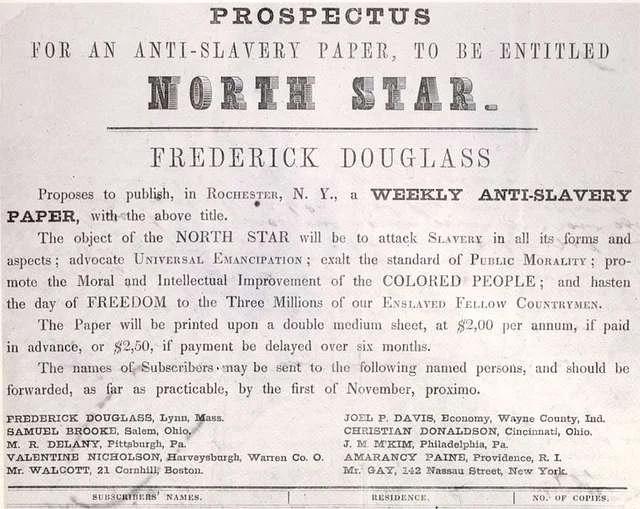Fighting for Freedom: The Legacy of the First Black Newspaper
By: Alex Nellis
Writing is a powerful tool. It can inspire us, change minds, and lift up voices that aren’t often heard. Famous activist writers such as Tricia Hersey, Michelle Alexander, and Ta-Nehisi Coates demonstrate that writing has the power to liberate and mobilize people for change. Before recent years, it was rarely discussed how Black writers have used their work throughout history to create societal change. The story of the first Black newspaper during the Civil War era illustrates writing’s legacy as a tool for liberation.
Q: How was the first Black-written newspaper founded?
A: During Civil War times in the US, most African Americans could not read because of anti-literacy laws. These laws prevented those who were enslaved from being educated.
In 1827, two free African Americans named John Brown Russworm and Samuel Eli Cornish broke barriers when they founded their own newspaper. The paper was completely Black-owned and operated along with other free Black abolitionists, who served as guest writers. They called the newspaper Freedom’s Journal, and published the first issue on March 16, 1827.
Q: What topics did Freedom’s Journal cover?
A: The paper covered a wide range of topics. Job openings were listed, helping free African Americans get employment. The classified section served a social purpose, including listings of births, deaths, weddings, and local advertisements. The advertisements spread the word about educational listings and affordable housing opportunities.
For only $3 per year, newspaper subscribers could also read current events and editorials. Their reader base was around 300,000 Northern African Americans. At the peak of its popularity, Freedom’s Journal was circulated in 11 states, as well as internationally in Haiti, Canada and Europe.
Q: What impact did Freedom’s Journal have on society?
A: Unlike any other newspaper at the time, the editorial section advocated for slavery abolishment. For the vast majority of whites, it introduced Black perspectives on politics, education and health. There was virtually no other published journalism or writing from Black perspectives at the time.
Most whites had only a surface-level understanding (if any) of how African Americans lived their daily lives. This paper was transformative for humanizing African Americans’ thoughts and ideas, and changed how society perceived their perspectives.
Q: How long was Freedom’s Journal published?
A: Major creative disagreements between Samuel Eli Cornish and John Brown Russworm led to the paper ending after six months. 103 issues in total were published. Russworm had wanted to shift the paper’s scope to advocating for African Americans returning to Africa due to their severe mistreatment in the United States. He stepped down from his role as co-owner to create a new paper focusing on this perspective, but it was not nearly as popular as Freedom’s Journal.
Cornish would briefly revive an ideologically similar paper to Freedom’s Journal in April 1829, under the name The Rights of All. However, the revival attempt was also short-lived, and the paper ceased publication later that year.
Q: What was the impact of Freedom’s Journal on Black newspapers?
A: Despite not lasting a full year, the societal impact of Freedom’s Journal was incredible. The paper showed African Americans the possibilities that could be unleashed if their voices were heard in mainstream media. Freedom’s Journal would inspire over 20 Black-owned and operated newspapers to start publication between 1827 and 1861.
After the Civil War, African Americans finally had access to education once the anti-literacy laws were lifted. Black newspapers started to thrive, and were an important outlet for inspiring social change and sharing Black perspectives. With their newfound freedom, Black newspapers were also used to encourage literacy and create community.
The first issue of Freedom’s Journal included a quote: “too often have others spoken for us.” Finally, African Americans had a platform for their own voices, and it was partly made possible because of the impact of Freedom’s Journal.
Q: Were there other papers that achieved the popularity of Freedom’s Journal?
A: Many Black newspapers had a wide reader base thanks to the inspiration of Freedom’s Journal, but the most famous Black-owned newspaper was The North Star. The paper was owned and written by famous Civil Rights pioneer Frederick Douglass. He named the paper after Polaris, the star that guided many people who were enslaved to their freedom in the North states.
The North Star was best known for fighting for abolitionism and covering current events with feminist and anti-racist perspectives. The paper was able to achieve a broader reach than Freedom’s Journal. Members of Congress and several presidents read the paper regularly, which amplified The North Star’s impact beyond Douglass’s imagination. The paper played an instrumental role in communicating Black perspectives to the nation’s top officials. Frederick Douglass helped establish Black journalism as a tool for social change.
The stories of Freedom’s Journal and other Black newspapers shows that Black writers have the power to advocate for change with their writing. The newspaper encouraged a generation of African Americans to become literate, which has continued to be passed down across generations. The journal also inspired society to see that change was essential, and showed the world that writing has the beautiful power to liberate.


